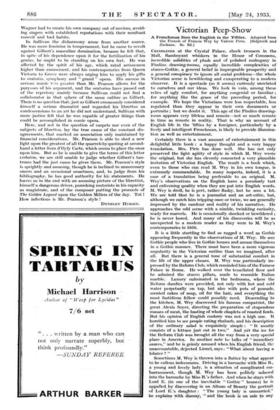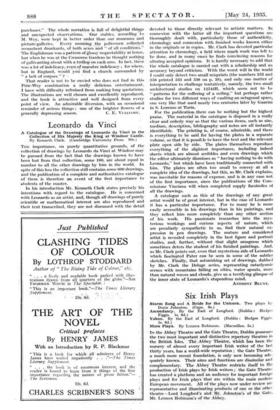Victorian Peep-Show
CRINOLINES at the Crystal Palace, check - trousers- in the Mall, flamboyant whiskers in -the House of Commons, incredible solidities of plush and of polished mahogany in Pimlico.- drawing-rooms, equally incredible complexities of stucco-Gothic, a general belief in impregnable prosperity and a general conspiracy to ignore all social problems—the whole Victorian scene is bewildering and exasperating to a modern observer. It is a spectacle (so it seems) curiously unrelated to ourselves and our ideas. We look in vain, among these relics of ugly comfort, for anything congenial or familiar ; for anything like the grace of the preceding period, for example. We hope the Victorians were less respectable, less regulated than they appear in their own documents or portraits ; but we doubt it. This age of the Pimlico drawing- rooni appears very lifeless and remote—not so much remote in time as remote in reality. That is why an account of English life in the 'fifties by a foreigner, particularly by a lively and intelligent Frenchman, is likely to provide illumina- tion as well as entertainment.
Certainly there is a vast amount of entertainment in this delightful little book : a happy thought and a very happy translation. Mrs. Pirie has done well. She has not only preserved the light agility of style in which M. Wey wrote the original, but she has cleverly concocted a very plausible imitation of Victorian English. The result is a book which, even to those who can read M. Wey in his own tongue, is extremely commendable. In many respects, indeed, it is a case of a translation being preferable to an original. M. Wey's observations on the English have a peculiarly tart and enlivening quality when they are put into English words. M. Wey is droll, he is pert, rather flashy, but he sees a lot. We are told that he is a journalist and an art-critic, but, although we catch him tripping once or twice, we are generally impressed by the candour and reality of his narrative. He approaches the odd scene with a nimble, twinkling curiosity, ready for marvels. He is occasionally shocked or bewildered ; he is never bored. And many of his discoveries will be as unexpected to a modern reader as they were to M. Wey's contemporaries in 1856.
It is a little startling to find so rugged a word as Gothic appearing frequently in the observations of M. Wey. He sees Gothic people who live in Gothic houses and amuse themselves in a Gothic manner. There must have been a more vigorous angularity -in the Victorian outline than we imagined, after all. But there is a general tone of substantial comfort in the life of the upper classes. M. Wey was particularly im- pressed by the Reform Club, which reminded him of the Farnese Palace in Rome. He walked over the tessellated floor and he admired the stucco pillars, made to resemble Italian
marble.- Luxury culminated in the bedrooms, where the Reform dandies were provided, not only with hot and cold water perpetually on tap, but also with pots of pomade, scented cakes of soap, oil for the hair, and everything the most fastidious fellow could possibly need. Descending to the kitchen, -M. Wey discovered his famous compatriot, the•
great Alexis Soyer, directing the preparation of stupendous masses of meat, the basting of whole chaplets of roasted fowls.
But his opinion of English cookery was not a high one. It horrified him to see people eating rhubarb, and his description of the ordinary salad is exquisitely simple : " It mostly
consists bf a lettuce just cut in two." And yet the ice for
the Reform Club was brought all the way from a very-special place in America. In another note he talks of ".incendiary sauces," and he is grimly amused when his English friend, the unaccountable, dejected Lionel, says : "What about having a lobster ?."
Sometimes M. Wey is thrown into a flutter by what appear to be callous indecorums. Driving in a barouche with Miss B., a young and lovely lady, is a situation of complicated em-
barrassment, though M. Wey has been politely ushered into the barouche by Miss B.'s father. And when he stays with Lord E. (in one of the inevitable " Gothic " houses) he is appalled, by discovering in an, Album of 'Beauty the portrait of Lord E.'s daughter : " The young lady is unmarried," he explains With disMay, " and the book is on sale to any purchaser." The whole narrative is full of delightful things and unexpected observations. Our stables, according, to M. Wey, were kept in better order than our museums and picture-galleries. Every morning, the policemen collected recumbent drunkards, of both sexes and of all conditions." 'The Englishman was a pattern of glossy respectability at home, but when he was at the Cremorne Gardens he thought nothing of gallivanting about with a trollop on`each arm. In fact, there vas a lot of indelicacy, even of macabre indelicacy ; for where, but in England, would you find a church surrounded by " a belt of corpses " ?
That reader is not to be envied who does not find in this Pirie-Wey combination a really delicious entertainment. I have with difficulty refrained from making long quotations. The illustrations are well chosen and excellently reproduced, and the book is attractive and well designed from every point of view. An admirable diversion, with an occasional reminder of serious things ; one of the brighter flowers of a















































 Previous page
Previous page